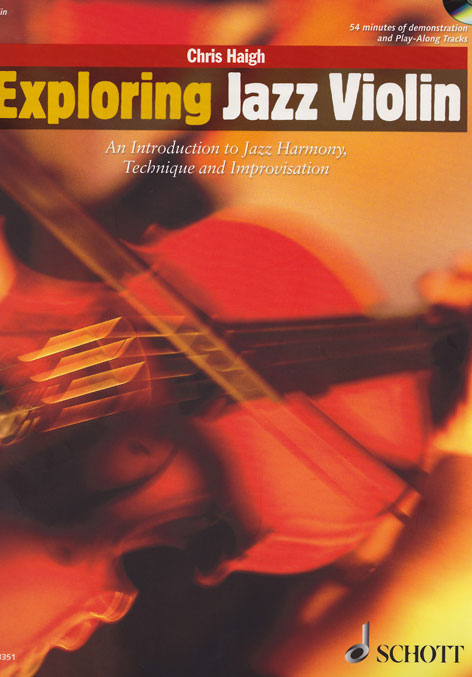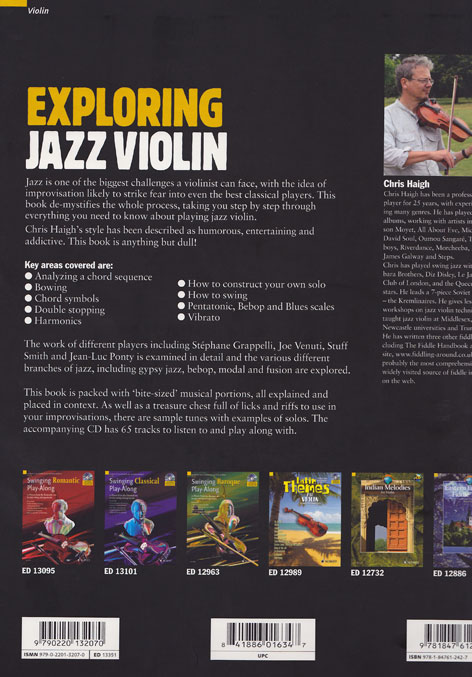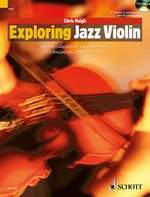
EXPLORING JAZZ VIOLIN;
A JAZZ VIOLIN BOOK
MENU TO FIDDLE STYLES:



EXPLORING JAZZ VIOLIN
by Chris Haigh

THE FIDDLE HANDBOOK
by Chris Haigh

OFF THE WALL (CD)
By Chris Haigh
"Erudite, witty...it's great." Pete Bibby Fiddle on Magazine
"It is a comprehensive beginner’s guide to jazz violin- a triumph!" Chris Garrick; The Strad
"an incredibly good value, comprehensive resource". Music Teacher Magazine
"an excellent broad look at playing all kinds of jazz on violin. I don't know of another book as thorough as this." -Graham Clarke, jazz violinist
"in my opinion one of the most definitive books on the subject of improvisation. Every fiddle player should have a copy even if jazz isn't your thing"-Gerard Murphy, fiddler
"Excellent resource" Julliard (Amazon review)
"An excellent treatment of jazz violin. Highly recommended"
-Throgmartin (Amazon review)
"Exploring Jazz Violin is a complete manual for players at all levels to plunge in and get started".
-All Things Strings
"...organization and pacing are first rate ...I highly recommend the book"
-Hollis Taylor. Stringendo
"A very useful resource if you want to learn jazz violin" -Mr P Hickey (Amazon review)
"It's fantastic, so clear and concise" -Sarah Harrison, violinist
"Excellent, comprehensive exploration of jazz method for violin" -Emily Smith , violinist
Jazz is one of the biggest challenges a violinist can face, with the idea of improvisation likely to strike fear into even the best classical players. This book de-mystifies the whole process, taking you step by step through everything you need to know about playing jazz violin. Chris Haigh’s style has been described as humorous, entertaining and addictive. This book is anything but dull! Key areas covered include analyzing a chord sequence; bowing; chord symbols; how to construct your own solo and how the various different branches of jazz, including gypsy jazz, bebop, modal and fusion are explored. This book is packed with ‘bite-sized’ musical portions, all explained and placed in context. As well as a treasure chest full of licks and riffs to use in your improvisations, there are sample tunes with examples of solos. The accompanying CD has 65 tracks to listen to and play along with.
CONTENTS:
1: It Don't Mean a Thing; how to swing; accents and "ghost notes"; syncopation; how to vary a phrase; chromatic and passing notes; how to play a "head"; slides, vibrato, rolls.
2: Starting to Improvise; riffs, licks and how to transpose them; filling gaps with runs and scales; bebop scales; playing by ear
3: Pentatonic Scales; pentatonic riffs; tonal centres; pentatonic finger patterns; pentatonic patterns in higher positions; other pentatonic scales.
4: The Blues; the 12-bar sequence; the minor pentatonic; the flattened third, fifth and seventh; blues licks; the minor blues; the importance of repetition.
5: Chords Part I; what is a chord?; understanding chord symbols; chords built from the major scale; chord types; II/V/I sequences and licks; minor II/V/I 's.
6: Chords Part II; the cycle of fifths; diminished and augmented chords; sus chords; chord extensions and substitutions; whole tone scales.
7: Masters of Swing; Joe Venuti; the double shuffle; yodels; parallel fifths; natural and artificial harmonics; Stuff Smith; syncopation; double stops; wide interval licks; chromatic cascades; octaves; double stopped trills; substitutions.
8: Stéphane Grappelli; the Hot Club; Grapelli's playing style 1934-9; sliding up to the flattened third; rolls, triplets and arpeggios; harmonics; Grapelli's later career; playig style post '39; step patterns; pedalling; flattened 9th licks; more harmonics.
9: Running Wild; Jean-luc Ponty; from classical to bebop to Zappa and solo jazz-fusion career; descending licks; whole tone scales; the double E riff; playing outside; chops and octaves; Didier Lockwood, Michal Urbaniak, L Shankar.
10: Other Styles, Other Players; gypsy jazz; hot club repertoire; bebop; arpeggios; chord extensions; enclosures; modal jazz; the modes; free jazz; latin jazz; claves and montunos; bossa.
11: The Big Night; how to learn and prepare a tune; using music; following an arrangement; learning the chords; preparing a solo; phrasing; taking risks; using "special effects"
12: Final Thoughts; gear; microphones, pikups, electric violins, amps, software; suggested listening and reading.
INTERVIEWS
The book was written with the help of interviews with many contemporary jazz violinists including Jean-luc Ponty, Chris Garrick, Mike Piggott, Billy Thompson, Ric Sanders, Alex Yellowlees, Tim Kliphuis and Sam Bardfeld.
THE RECORDING
This jazz violin book comes with 65 tracks on CD, including all the tune examples, with and without the violin top line. There are also backing tracks to practice individual chord types, II/V/I's, and the cycle of fifths.Two bands were used to make the recording; a gypsy jazz quartet; Chris Haigh(fiddle), Stuart Blagden and Jez Cook (guitars) and Raph Mizraki (double bass); and a "modern" band; Chris Haigh (fiddle); Geoff Castle (piano), Dudley Phillips (bass guitar) and Roy Dodds (drums).
author: Chris Haigh
An introduction to jazz harmony, technique and improvisation
Instrumentation: Violin
Publisher: Schott Music
Difficulty: intermediate
Edition: edition with CD
Language: English
Series: Schott Pop-Styles
208 Pages - Paperback/Soft Cover
ISMN: 979-0-2201-3207-0
ISBN: 978-1-84761-242-7
Order number: ED 13351
Price: £16.99
plus delivery
"It's the first really relevant, comprehensive introduction to jazz violin I've seen. Others have been mainly solo transcriptions and some biographies, but no clear idea of how to improvise on the violin - particularly how to swing. The examples and backing CD make each step very clear. It also covers a wide range of individual players' styles. It will be very useful when I do the occasional workshop."
-Mike Piggott
"Congratulations to Chris Haigh for creating a well≠organized, useful jazz≠method book. Haigh draws in his readers with familiar major scales. He gently walks them through pentatonic and blues scales. He weaves in stylistic hints to help players sound more authentic. Then he bravely leads his readers through the complex world of jazz theory and harmony. And to make it friendly, he laces the book with just enough humor to get his readers excited about doing the necessary work. His explanations are clear, concise, and charming. Most helpful are the short musical examples that capture the musical essences of each player he discusses. His insightful analysis makes it possible to do more than just play by rote, but to internalize the ideas and make them your own.
The biographical info is fantastic, too. This book tells a compelling history of the most influential jazz violin players of the last 100 years and details characteristic musical elements of their playing that makes each one unique. Exploring Jazz Violin offers great insight into the socio≠ economic factors that affected the careers and even the playing styles of the jazz violin greats.
Hopefully future editions will include discussion of more contemporary luminaries like Matt Glaser, Mark Feldman, and Chris Howes. The section on Latin music is a bit weak, but Haigh aptly suggests the reader seek out Sam Bardfeldís spectacular book Latin Violin. It might have been more useful to include a section on great jazz violinists who have developed their improvisation styles via American and Celtic fiddle traditions, such as Darol Anger, Jeremy Kittel, Richard Greene, and Mark OíConnor. Exploring Jazz Violin is a complete manual for players at all levels to plunge in and get started".
This article appeared in All Things Strings July 2012
Exploring Jazz Violin Reviewed by Pete Bibby; Fiddle on Magazine Spring 2011-03-04
I must admit, when I started this piece, I had a problem. Last time I reviewed a book by Chris Haigh- the excellent Fiddle Handbook- I went over the top a bit in recommending it. Having said that, I havenít been approached in dark alleys by fiddlers who bought it and were disappointed. Quite the opposite. The trouble was that I felt exactly the same way about this new tome, Exploring Jazz Violin, when I got it. Itís great. Erudite, witty, and, unlike some jazz fiddle books, it doesnít assume any rarefied musical knowledge but starts at the basics and moves on step by step. I worried I may be accused of haighophilia (or is it hagiography?).
Then, I found something I could criticise. A minor point, a nitpicking I should be ashamed of, but Iíll use it to keep my session cred. But that comes later. First all the good bits. And there are lots of them. After an introduction to swinging, melody improvisation and lick construction, the book goes on to the blues by way of scales (both pentatonic and bebop) and higher positions. Then it arrives at chords, two whole chapters, explaining what chords are and what they mean to fiddle players. Next come four chapters on jazz violinists and their styles, there are more of tem than you might think. After those comes a chapter on The Big Night when you swing in public for the first time which is funny and full of practical advice. Advice like "Jazz Violin is easy- just play what you feel"; which is followed up with; " thatís perhaps the worst piece of advice youíll ever hear". And carries on to fill the book with better advice, presented in small, well-explained chunks backed up with a wealth of musical examples in fiddler-friendly keys and an example cd with 65 tracks. And hereís my very minor niggle. There are lots of examples in the book that donít make it to the cd. And thatís a pity, because while only basic music reading is needed, it would be nice to hear how the examples should sound. Maybe theyíll turn up on Chrisís website.
Exploring Jazz Violin; reviewed by Chris Garrick in The Strad:
This robust and beautifully presented publication, complete with full-page photographs, would grace any coffee table. Chris Haigh, a London-based violinist, is extremely experienced in jazz and folk playing. He writes with clarity and good humour and takes us on a journey through myriad styles, tunes, techniques, tunes and practical matters. Exploring Jazz Violin is loaded with ideas and instructions for the fledgling improviser.
It is clearly and concisely laid out in bite-size chunks and it climbs steadily and sure-footedly from beginner up to intermediate level. The book is divided into two main sections. The first deals with playing, and Haigh offers guidance for tackling new physical and mental techniques. The second section focuses on the history of the art, with biographical data on the greats, from Stephane Grappelli to Stuff Smith and Jean-Luc Ponty.
The play-along CD, which contains examples and accompaniments to Haighís clearly written exercises, patterns and tunes, is indispensible. The two most typical instrumental settings for jazz violin-guitar-led ďhot clubĒ and piano trio bands- are employed as support, a judicious decision that offers the beginner the golden opportunity to experience playing with distinctive, contrasting backings. Haigh has embraced his subject fully and coherently, touching on just about every aspect of jazz violin.
It is a comprehensive beginnerís guide to jazz violin- a triumph!
Exploring Jazz Violin; reviewed by Music Teacher
"This is a serious handbook (youíll see what I mean when you pick it up) containing everything you need to know to start playing jazz. It assumes some basic knowledge of music theory and violin technique, but no previous jazz experience. In his humorous and informal style, Chris Haigh introduces the novice first of all to swing, and then to various ways to improvise using different scales and chords. This is done in a carefully graded way, with demos and backing tracks to consolidate each point. Throughout, you are given riffs or licks which you can try out immediately on the original numbers Haigh has written for the book and then store for future use.
Crucially, the book introduces the masters of jazz violin, from Joe Venuti to Jean-luc Ponty, putting each player and his style into context and providing a useful list of suggested listening. Finally there is expert advice on how to approach your first gig, making this an incredibly good value, comprehensive resource."
"Excellent resource. This book is a wonderful way to introduce improvization to students. It assumes a fair degree of proficiency on the violin (advancing student) but takes the student step by step through skills needed to develop an individual improv style. A CD is included which helps boost a student's confidence playing".
-Julliard (Amazon review)
"Thanks again - the book is excellent. Very clear explanations of everything. I did a jazz module when I was at university and got put off as I thought I was no good. But we were just told to 'improvise' which didn't give much clear direction... I am finding this much better!"
-Emily
" I was finally persuaded to teach a classical violinist to play Gypsy jazz after many years telling myself I didnít know enough about it myself! She brought your book along to the lesson last week and itís fantastic! So clear and concise! And I love the warm, entertaining personal tone of your writing too! And the analysis of different violinists. All of it! I wish it had been around when I was starting out! Anyway thanks for all your hard work and dedication! Iím gonna buy it as a textbook for teaching and for my own improvement!" -Sarah Harrison, violinist
...........................................................................................................
HOW TO BUY "EXPLORING JAZZ VIOLIN"
If you're in the UK you can get it here by paypal for just £26.00 (including postage & packing)
If you're outside the UK but in Europe, add £8 for postage. Outside Europe add £10. In the US you can get it here from Hal Leonard:
Return to fiddlingaround.co.uk homepage
Chris Haigh is a freelance fiddle player based in London. His playing covers a huge range of styles, all played with commitment and authority. He has played on over 70 albums. He has two books published by Spartan Press; "Fiddling aroud the World" and "Any fool can write Fiddle Tunes", and "The Fiddle Handbook" is published by Backbeat/Hal Leonard. He has six books published by Schott, covering rock, jazz, folk, klezmer, Hungarian and French fiddle.